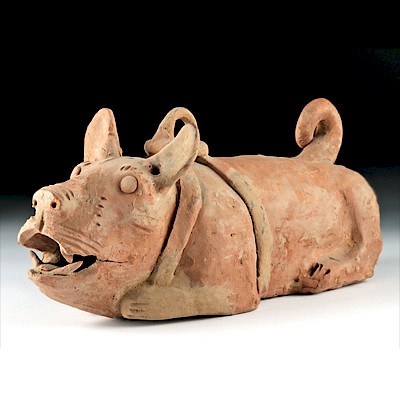Aztec Pottery Vessel - Gourd or Cacao Pod - Rare!
Lot 94a
About Seller
Artemis Gallery
686 S Taylor Ave, Ste 106
Louisville, CO 80027
United States
Selling antiquities, ancient and ethnographic art online since 1993, Artemis Gallery specializes in Classical Antiquities (Egyptian, Greek, Roman, Near Eastern), Asian, Pre-Columbian, African / Tribal / Oceanographic art. Our extensive inventory includes pottery, stone, metal, wood, glass and textil...Read more
Estimate:
$800 - $1,200
Absentee vs Live bid
Two ways to bid:
- Leave a max absentee bid and the platform will bid on your behalf up to your maximum bid during the live auction.
- Bid live during the auction and your bids will be submitted real-time to the auctioneer.
Bid Increments
| Price | Bid Increment |
|---|---|
| $0 | $25 |
| $300 | $50 |
| $1,000 | $100 |
| $2,000 | $250 |
| $5,000 | $500 |
| $10,000 | $1,000 |
| $20,000 | $2,500 |
| $50,000 | $5,000 |
| $100,000 | $10,000 |
| $200,000 | $20,000 |
About Auction
By Artemis Gallery
Sep 13, 2018
Set Reminder
2018-09-13 10:00:00
2018-09-13 10:00:00
America/New_York
Bidsquare
Bidsquare : Ancient | Asian | Ethnographic - Fall Variety
https://www.bidsquare.com/auctions/artemis-gallery/ancient-asian-ethnographic---fall-variety-3432
Travel the world and back in time... Antiquities from Egypt, Greece, Italy and the Near East, Asian, Pre-Columbian, African / Tribal / Oceanic, Native American, Spanish Colonial, Russian Icons, Fine Art, much more! Artemis Gallery info@artemisgallery.com
Travel the world and back in time... Antiquities from Egypt, Greece, Italy and the Near East, Asian, Pre-Columbian, African / Tribal / Oceanic, Native American, Spanish Colonial, Russian Icons, Fine Art, much more! Artemis Gallery info@artemisgallery.com
- Lot Description
Pre-Columbian, Valley of Mexico, Mexico City region, Aztec, ca. 1200 to 1520 CE. A beautiful sculpture most likely depicting a cacao pod - skillfully modeled in terracotta. In her book, "Sacred Consumption: Food and Ritual in Aztec Art and Culture" (University of Texas Press, 2016, p. 44), Elizabeth Moran writes, "Food items were rendered by Aztec artists in a wide range of materials. Aztec stone workers made huge sculptures of cacti, squash, and pumpkin out of different stones; some scholars suggest that these huge food items were permanently on display in temples." This piece of course is ceramic, and most likely represents a cacao pod. See Moran's discussion of a large sculpture of a man holding a cacao pod housed in the Brooklyn Museum in the extended description below. Chocolate was believed to have medicinal value as well as aphrodisiac qualities in ancient Mesoamerica, and it played a major role in ceremonial rituals ranging from marriage to funerary rites. Size: 6.25" in diameter x 7" H (15.9 cm x 17.8 cm)
Moran also describes a sculpture of a man holding a cacao pod by the stem at the Brooklyn Museum of Art that is just over 2 feet tall. She writes, "The male figure holds a disproportionately large pod . . . Here the cacao pod is transformed into a monumental food. Its large size denotes its significance. Cacao was a specialty item in the Mesoamerican world." Scholars suggest that the Aztecs believed that cacao seeds were actually gifts from Quetzalcoatl, the god of wisdom. Cacao seeds once possessed so much value and were used as a form of currency. Cacao was initially only prepared as a beverage. Unlike the sweet drink we consume today, the liquid chocolate was enjoyed as a bitter, frothy drink, blended with spices or at times corn puree. The indigenous believed is possessed aphrodisiac powers and at the same time gave the drinker increased strength. Today, these drinks are called "Chilate" and are made by the peoples residing in the South of Mexico.
Provenance: private New York, New York, USA collection; ex-private lifetime collection of Dr. Saul Tuttman and Dr. Gregory Siskind, New York, New York, USA
All items legal to buy/sell under U.S. Statute covering cultural patrimony Code 2600, CHAPTER 14, and are guaranteed to be as described or your money back.
A Certificate of Authenticity will accompany all winning bids.
We ship worldwide and handle all shipping in-house for your convenience.
#137519Loss to stem. Expected surface wear with old nicks and abraded areas as shown. Inventory number "AAU7" written in black ink on base.Condition
- Shipping Info
-
All shipping is handled in-house for your convenience. Your invoice from Artemis Gallery will include shipping calculation instructions. If in doubt, please inquire BEFORE bidding for estimated shipping costs for individual items.
-
- Buyer's Premium



 EUR
EUR CAD
CAD AUD
AUD GBP
GBP MXN
MXN HKD
HKD CNY
CNY MYR
MYR SEK
SEK SGD
SGD CHF
CHF THB
THB
















